Last week at Books in Browsers IV, Baldur Bjarnason gave a talk titled Interactivity Is What You Do that I kept referring back to over the two days of sessions. He pointed out that interactive media isn’t what you watch, hear or read, but is “composed of the meaningful actions the user takes while interacting with your work.” There are two affirming ideas in this statement. One is that “meaningful actions” has a wide enough scope to include all behaviour. Second is that producers of interactive works build an entire experience, not simply an object, for an audience.
I urge you to read the BiB IV round-ups by organizer Peter Brantley, speaker Anna von Veh, and BrianO’Leary summarizing the different themes we saw running through this year’s conference: digital design and code, paratext, and collaborative creation. In addition to these, I also saw a focus on creating an end-to-end user experience that includes authoring as part of that experience. Speakers Mandy Brown of Editorially, a transformational collaborative writing/editing tool, and Doubleday Random House Canada author, Kate Pullinger, with her API for her book Landing Gear, made good examples of how an author’s capacity as both a producer of interactive content and an end-user has expanded with the use of digital production technologies.
Others had approaches to reading interaction that have a great deal of potential. The Hypothes.is group discussed two open-source projects, Epub.js and Open Annotation, that caused a flurry of excitement. Epub.js is a JavaScript library that can render EPUB files in a browser. It removes the need for an app or a plugin to read ebooks. Try out their demo of Moby Dick to see exactly why I think this is cool. Their Open Annotation project, also named Hypothes.is, attempts to envelop the web in an annotation layer that is freely accessible and peer-reviewed.
Returning to my original thought, I think the best lesson from BiB IV was that our newfound ease with tool development and collaboration will help us move beyond object production and into creating entire experiences. A hugely memorable example of what this march looks like came from Dominique Cunin’s talk on the image-object relationship and a brilliant show & tell of all the cool stuff they get up to at Les éditions volumiques. Forget being beaten by format differences, let’s follow this guy to wonderland:



